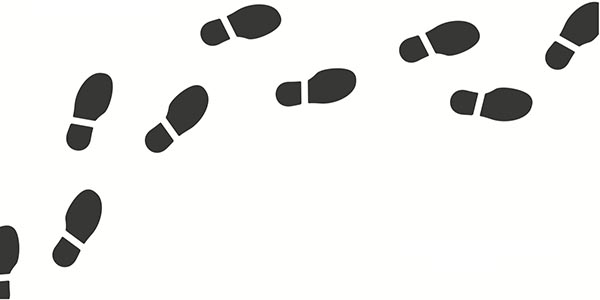
When your customers are looking to boost sales with wide-format graphics, should they encourage their customers to look up or down? While much of the fanfare in wide-format graphics goes to signs, banners and floor displays, floor graphics have a powerful track record of sales lifts, too.
What’s behind the success of these sticky ad spaces? Maybe it’s that so many shoppers are looking down at their phones in the retail aisle that floor graphics are now at eye level. Or maybe it’s just because floor graphics are unexpected to the shopper’s eye. Regardless of the reason, they work. Let’s look at some of the numbers behind those results.
Engaging…for Longer
According to research by the Point of Purchase Advertising Institute, 64% of shoppers stop and engage when they see floor graphics. Not only do they notice, but shoppers stay longer in the featured product area. Indeed, POPAI found that, in one study, the number of shoppers stopping in the product area for more than eight seconds increased by 280%.
Other results from the research? Products promoted with floor graphics and mats showed sales increases of 10% to 13%. For grocery, a brand can expect a 16% sales increase using floor graphics.
Another study at the Center for Advanced Retail and Technology reinforced these findings. Its research concluded that the use of colorful, custom floor graphics (in this case, those used to sell cereals) resulted in a 17% lift in sales compared to visual merchandising that did not.
Furthermore, 11.2% of shoppers who made a purchase from that product area were new or re-engaged, defined as not having bought the featured brand of cereal in the previous six months.
Increasing Sales by 20–50%
Multiple printers, including Windo Displays, Go To Shout, and Wallace Print, cite the same research that when a store uses floor decals in the aisle, sales increased 20-50%. Brand image also improves.
Case studies reflect these realities “on the ground” as well. Consider the following three examples:
A national retail chain reported extraordinary success after employing floor graphics to market a name-brand insecticide. After placing multiple six-foot-square graphics of bugs “succumbing to Raid” on the store floor, sales rose 91%.
In a study on behalf of FLEXcon, researchers looked at the impact of floor graphics on the sales of garden supplies and work wear at Klems, a department store. They found that large floor graphics showcasing Carhartt work clothes led to a 31% increase in sales.
One year later, researchers used the sales floor of the same department store to study the impact of brightly colored floor graphics showcasing Scott’s Miracle-Gro products, leading customers toward displays at the back of the store. This case study, too, had compelling results: 29% sales increase for Scott’s Miracle-Gro and an overall sales boost of 18% for the gardening department.
In another example, Specialty Graphics Solutions collaborated with iQ Credit Union to create floor graphics for a quarterly marketing campaign. These graphics featured animal paw prints, along with informative messages about the credit union's services, to guide customers through the financial institution’s local branches. The campaign was so successful that iQ extended its use for an additional month beyond the original plan.
All It Takes Is an Arrow
On its blog, Horizon Sign Company cited an older but still relevant study conducted by Emerald Group Publishing:
The floor graphic was as simple as they come—just a red arrow pointing in the direction of a particular product display—but that was all it took to make a big impact on in-store buyer behaviors and decision-making.
Why did the floor graphics in this study work so well? In explanation, the print shop cited research from the International Journal of Business and Management Invention.
While some in-store ads can seem invasive, especially those that block walkways or otherwise take up space . . . floor graphics have a “high level of [consumer] acceptance, as they are not interfering in the customer purchase.” This higher level of consumer acceptance is associated with better ad engagement and recall, as well as higher conversion rates.
“Stop and Look”
FM Event Promotions is another business promoting the value of floor graphics. On its website, it cites the results of a study that found that when a business uses aisle decals, nearly 25% of consumers stopped to look at the decal while shopping, brand reputation increases, and sales rise 25-55%.
From survey results to real-world case studies, it’s clear that floor graphics can be a powerful tool. The data consistently demonstrates that these eye-catching tools can capture customers' attention, guide them through the store, and ultimately drive purchases.
Suddenly, shoppers with their noses stuck to their cellphone screens just might be a good thing.















Discussion
Only verified members can comment.